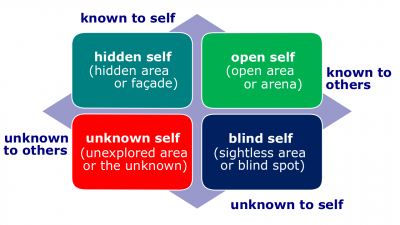Difference between revisions of "Johari Window"
(→Related coursework) |
|||
| (One intermediate revision by the same user not shown) | |||
| Line 1: | Line 1: | ||
[[File:Johari.png|400px|thumb|right|[[Johari Window]]]][[Johari Window]] is a tool used to illustrate and improve self-awareness, and mutual understanding between individuals within a group. [[Johari Window]] can also be used to assess and improve a group's relationship with other groups. | [[File:Johari.png|400px|thumb|right|[[Johari Window]]]][[Johari Window]] is a tool used to illustrate and improve self-awareness, and mutual understanding between individuals within a group. [[Johari Window]] can also be used to assess and improve a group's relationship with other groups. | ||
| + | |||
| + | ==Definition== | ||
| + | According to [[Looking Out, Looking In by Adler, Proctor (15th edition)]], | ||
| + | :[[Johari Window]]. A model that describes the relationship between self-disclosure and self-awareness. | ||
| + | |||
==Related lectures== | ==Related lectures== | ||
*[[Human Perceptions Quarter]]. | *[[Human Perceptions Quarter]]. | ||
| − | [[Category: Septem Artes Administrativi]][[Category: Articles]] | + | [[Category: Septem Artes Administrativi]][[Category: Articles]][[Category: Human Communications]] |
Latest revision as of 17:02, 10 July 2020
Johari Window is a tool used to illustrate and improve self-awareness, and mutual understanding between individuals within a group. Johari Window can also be used to assess and improve a group's relationship with other groups.
Definition
According to Looking Out, Looking In by Adler, Proctor (15th edition),
- Johari Window. A model that describes the relationship between self-disclosure and self-awareness.
